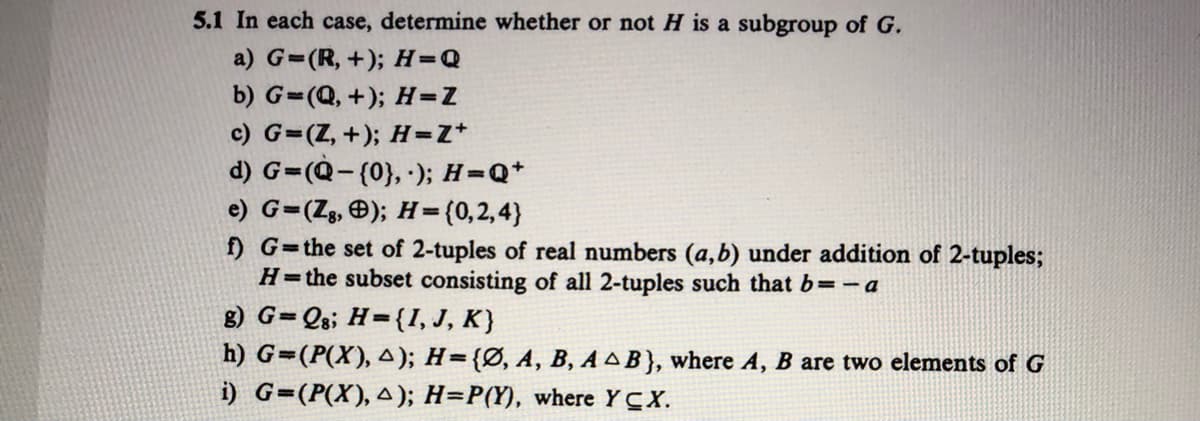5.1 In each case, determine whether or not H is a subgroup of G. a) G=(R, +); H=Q b) G=(Q, +); H=Z c) G=(Z, +); H=Z* d) G=(Q-(0}, ); H=Q*
5.1 In each case, determine whether or not H is a subgroup of G. a) G=(R, +); H=Q b) G=(Q, +); H=Z c) G=(Z, +); H=Z* d) G=(Q-(0}, ); H=Q*
Elements Of Modern Algebra
8th Edition
ISBN:9781285463230
Author:Gilbert, Linda, Jimmie
Publisher:Gilbert, Linda, Jimmie
Chapter4: More On Groups
Section4.4: Cosets Of A Subgroup
Problem 32E: (See Exercise 31.) Suppose G is a group that is transitive on 1,2,...,n, and let ki be the subgroup...
Related questions
Question
100%

Transcribed Image Text:5.1 In each case, determine whether or not H is a subgroup of G.
a) G=(R, +); H=Q
b) G=(Q, +); H=Z
c) G=(Z, +); H=Z*
d) G=(Q-(0}, ); H=Q+
e) G=(Zg, Ð); H=(0,2,4}
f) G=the set of 2-tuples of real numbers (a,b) under addition of 2-tuples;
H=the subset consisting of all 2-tuples such that b=-a
g) G=Qs; H={I, J, K}
h) G=(P(X), A); H={Ø, A, B, A AB}, where A, B are two elements of G
i) G=(P(X), A); H=P(Y), where YCX.
Expert Solution
This question has been solved!
Explore an expertly crafted, step-by-step solution for a thorough understanding of key concepts.
This is a popular solution!
Trending now
This is a popular solution!
Step by step
Solved in 2 steps

Recommended textbooks for you

Elements Of Modern Algebra
Algebra
ISBN:
9781285463230
Author:
Gilbert, Linda, Jimmie
Publisher:
Cengage Learning,

Elements Of Modern Algebra
Algebra
ISBN:
9781285463230
Author:
Gilbert, Linda, Jimmie
Publisher:
Cengage Learning,